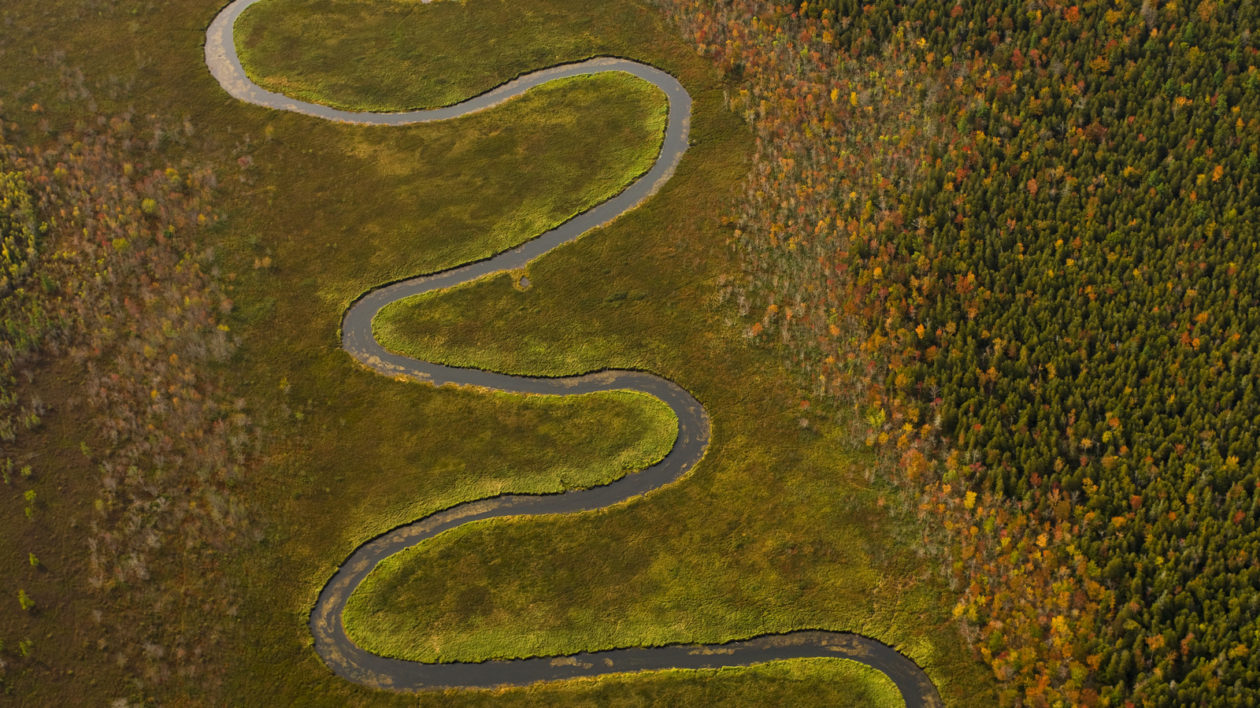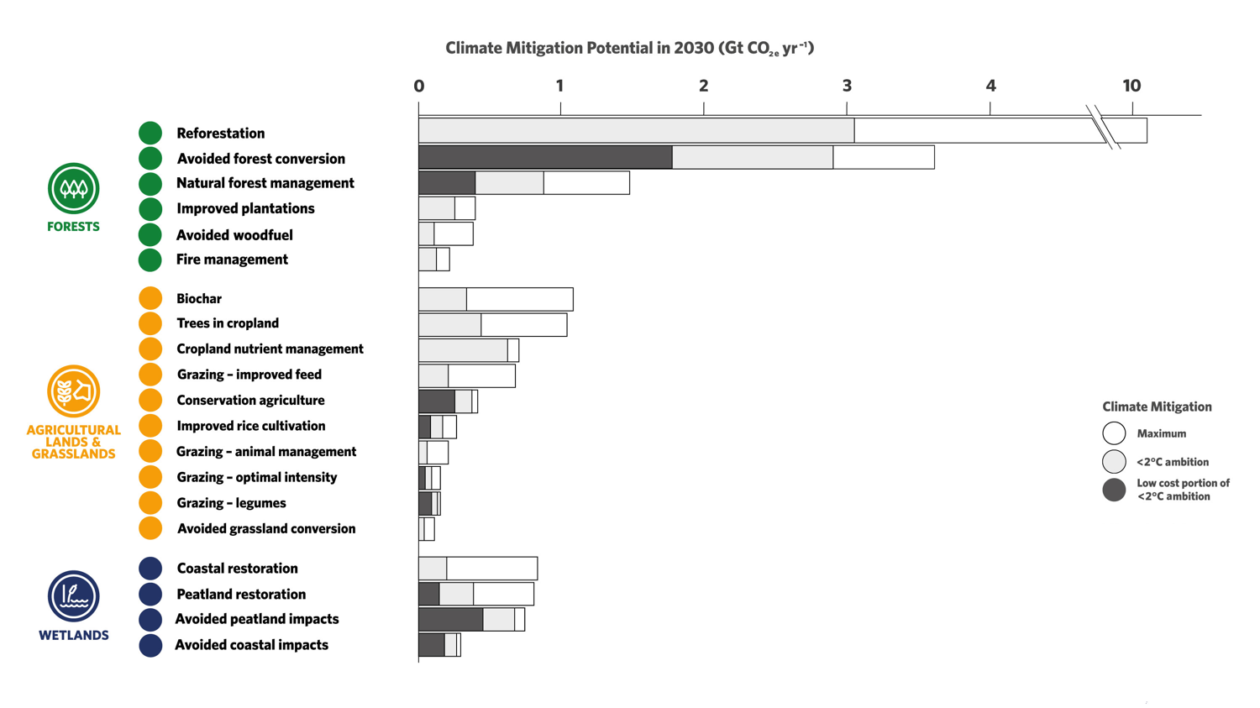Nature is always cast as the victim in the climate change drama. But what if nature could be the superhero?
We have vastly underestimated the potential for nature to fight climate change, when combined with better stewardship and restoration. New research from Nature Conservancy scientists and their partners indicates that nature can provide 37 percent of the emissions reductions needed to hold global warming below 2 degrees Celsius by 2030. And it can do so in a cost-effective manner that enhances other economic benefits from natural systems, too.
Tipping the Carbon Scale
Carbon dioxide didn’t used to be a problem — but we’ve made it one. The vast majority of the global carbon cycle is driven by nature. A tree falls, and as it decays some of its carbon atoms dissolve into the atmosphere. Some rain down upon the ocean and sink to its depths, where they’re compressed into sediment and rock, while others fall on land and are locked up again in vegetation. Despite the myriad pathways those atoms take, it’s a system in balance, with carbon flowing to and from the atmosphere in roughly equal amounts. Until you factor humans into the equation.
“Humans only impact a small portion of this ebb and flow of carbon each year, but the problem is that we only influence it in one direction,” says Bronson Griscom, the director of forest carbon science at The Nature Conservancy. Human activities have created a 40 percent increase in carbon dioxide in the air since the industrial revolution. While that number is just a small portion of the overall carbon cycle, it’s more than enough to tip the scales in the wrong direction.
The culprits aren’t just our coal factories, cars, or rampant consumption. Human damage to nature — whether from deforestation, or agriculture, or development — creates about 25 percent of all human greenhouse gas emissions. But rather than just playing the victim, nature can provide a massive solution.
“Not only can we stop damaging nature, but we can also restore, it, too,” says Griscom. “And when you put the two together, you get powerful and natural solutions to climate change.”

Natural Solutions to Fight Climate Change
Griscom and a team of global scientists set out to create the most comprehensive to-date assessment of nature’s potential to mitigate climate. Building on a large body of existing research, they divided natural carbon sinks into 20 different pathways and then calculated both their potential for emissions reductions and the associated costs. The pathways grouped into three larger units: forests, wetlands, and agricultural lands / grasslands. Unlike some previous estimates, the researchers constrained these calculations by accounting for the inevitable demands on nature for fuel, food, and fiber.

Their results, published recently in Proceedings of the National Academy of Sciences, showed that investment in these 20 natural mitigation pathways can reduce emissions by 11.3 billion tonnes of CO2 per year in a cost effective manner. That accounts for 37 percent of the emissions reductions needed to hold global warming below 2 degrees Celsius by 2030 — the benchmark outlined in the 2010 Paris Agreement.
And if you ignored cost-effectiveness, these 20 pathways have a maximum mitigation potential of 23.8 billion tonnes per year. Griscom says that this figure is more than 30 percent higher than previous estimates, both constrained and unconstrained, because this research filled gaps and included more natural pathways than prior syntheses.
Amongst the 20 natural climate solutions, forests rise to the top. “The three pathways with the greatest potential are reforestation, avoided deforestation, and improved forest management,” says Griscom. Together, those three pathways contribute more than 60 percent of the cost-effective nature-based mitigation needed to keep warming below 2 °C by 2030. These forestry pathways are also attractive because of existing regulatory frameworks and the possibility of quick implementation without changes to land tenure.
In the group of agricultural and grassland pathways nutrient management stands out for its low-cost emissions reductions and other benefits. “Reducing and optimizing the application of fertilizers to croplands can avoid a lot of unnecessary nitrogen emissions,” says Griscom. It can also save farmers money, improve crop yields in cases where farmers are over-fertilizing, and greatly benefit biodiversity in freshwater ecosystems. Bronson also says that grazing pathways are key particularly because they can free up land for reforestation.

Another standout is avoided destruction of wetlands. “They aren’t as extensive as forests or agricultural lands, but they’re the most carbon-dense systems on earth,” says Griscom. Wetlands — including mangroves, marshes and peatlands — also provide a multitude of high-value ecosystem services, including filtering water and buffering storm surges.
Many of the 20 pathways have similar ecosystem service benefits. While the researchers did not incorporate the economic value of additional ecosystem services into their cost calculations, they did review the literature and document the additional benefits provided by each of the 20 pathways. (See figure above.)
Griscom and his colleagues hope that their work will provide nations a straightforward, reliable, and cost-effective set of options to reduce their emissions reductions targets.
“What we are confronting right now is that even really aggressive efforts to reduce emissions will not be enough,” says Griscom. “We also need to reverse our emissions, and it turns out that good old photosynthesis is the most inexpensive and reliable way to suck carbon out of the atmosphere and store it.” And unlike nascent technologies, like carbon capture and storage, nature doesn’t need decades before it becomes cost-effective at scale.




I’d like more information on how nature fights climate change. It nice to know that trees are so beneficial the the co2 emissions fight to balance climate change. Thank you for the article. I’ll be looking forward to the next update.